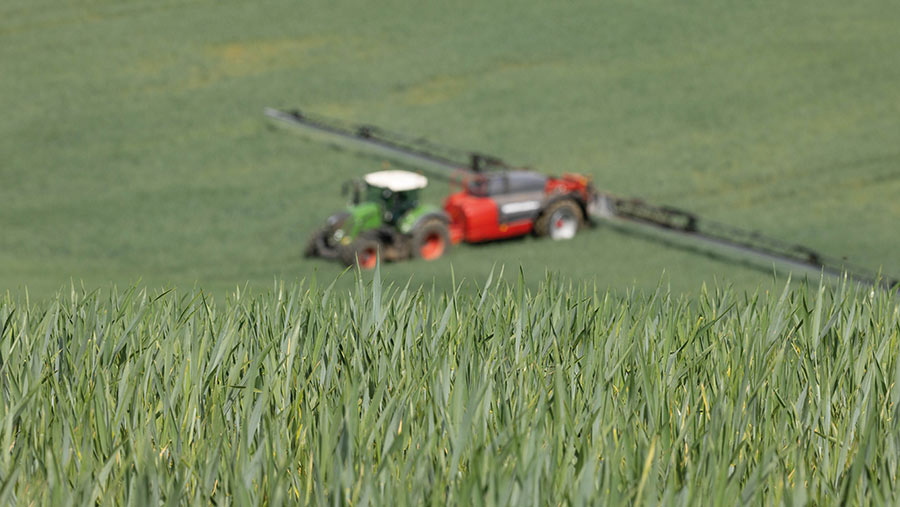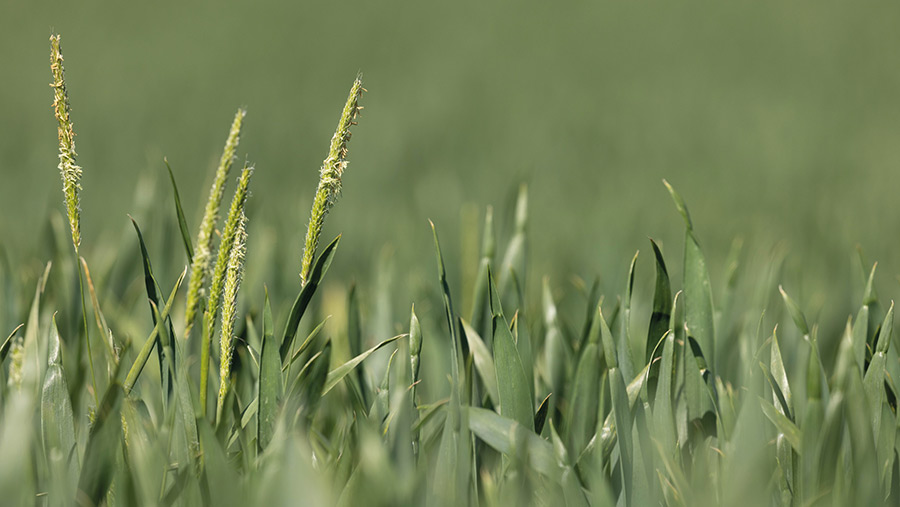Crop Watch: Time for T2 sprays as settled spell arrives
 © Tim Scrivener
© Tim Scrivener Septoria is at alarming levels in many wheat crops and the weather has settled down in time for the all-important T2 spray.
Hopefully, it means these fungicides will go on in more optimal conditions and the drier weather will help dampen down the disease.
However, despite there being no significant rain for 10 days, there is still a lot of maize to drill in the South West, as it has taken time for soils to dry out enough for cultivations to produce good seed-beds.
See also: Biological brews help grower keep crop disease at bay
North
David Martindale
Arable Alliance (Yorkshire)
The past month has continued to be a real struggle to complete field operations of any kind. Rain falling almost daily, sometimes in large amounts, has caused some serious delays and increased frustration all round.
Any happiness has been shared between wet-weather-loving diseases, such as septoria tritici and rhynchosporium, along with disease researchers who will be enjoying seeing differences between varieties and fungicide programmes.
No doubt they will be demonstrating huge fungicide yield responses in the coming winter months.
Some tramlines on heavier land have taken a real hammering and reflect how difficult it has been to get on and apply crop inputs.
At least the first settled spell since mid-February has arrived at a good time to apply the T2 fungicides to winter wheat in optimal conditions.
Septoria has continued to develop in winter wheat and is at alarming levels in early-sown crops with low resistance to this disease.
Where the T1s were applied late, this has made the situation worse with septoria now appearing on leaf three.
Some T1.5 fungicide applications have been made in the highest-risk situations to try to protect leaf two and reduce the reliance on the T2 fungicides for eradicating infection.
With a long latent period of two to three weeks from infection to leaf symptoms appearing, septoria is a sneaky disease where it can lull you into a false sense of security.
Consequently, robust T2 fungicide mixes have been required to keep on top of septoria as the top two leaves alone contribute about 70% towards final yield.
Barley
Winter barley crops are looking resplendent as the wind ripples across the crops. Spring barley crops are more of a mixed bag, with growth stages ranging from leaf three to flag leaves emerging.
Rhynchosporium is appearing in spring barley crops sown during the mid-February drilling window so T1 fungicides have been robust to keep this disease under control.
With plenty of moisture this spring, many of these earlier sown crops are requiring some late-season plant growth regulation in order to reduce brackling.
Oilseed rape crops have improved where they were struggling with cabbage stem flea beetle larval feeding or damage from pigeons.
Several growers have been pleasantly surprised by how these crops have improved when applying the sclerotinia fungicide.
With flowering proving to be prolonged due to the cool, wet conditions, many crops are receiving a second fungicide to control sclerotinia.
Seed weevil numbers have also increased recently so an insecticide has been required where thresholds have been exceeded.
Winter beans are now in full flower and have grown significantly in the past two weeks.
Broad-leaved weed control from bentazone this spring has been disappointing due to the cool conditions, and crop competition is now the only means of weed suppression.
Chocolate spot pressure is very high in these crops, with two fungicide applications only just doing enough to contain this disease.
Some settled weather now is likely to help reduce further disease spread.
Chocolate spot is also evident in spring bean crops, along with high levels of downey mildew in some cases. Fungicide costs in bean crops this year are likely to be well above average.
West
Neil Potts
Matford Arable (Devon)
At the time of writing the weather has finally dried up and we have had no rain for 10 days or more.
This in itself is now causing problems, with soils drying out too quickly, creating soil caps in sown fields and hard, difficult-to-work seed-beds where the planned crop is not yet sown.
These are principally maize seed-beds, although fodder beet and later-drilled spring cereals have also been affected.
In short, this season just keeps on giving and amply illustrates the point that the more rain you have had, the more you need to continue having it.
Winter OSR crops continue to look well and have a really good podset, with little or no visible signs of any disease.
The cool, wet weather has lead to an extended flowering period that has lasted at least six weeks. It remains to be seen whether this will be a positive or not.
The winter barley crops are on the whole looking very promising and fungicides, where applied in a timely fashion, have done a really good job at controlling disease.
The biggest threat to yield this year is significant levels of barley yellow dwarf virus in crops where growers failed to get enough/any aphicide on last autumn.
Delayed nitrogen top dressings have also played a part in diminishing the potential of some crops.
Major headache
Septoria in wheat continues to be the major headache of the season, with even well-timed programmes struggling to keep this damaging disease out of the top three leaves.
Poorly timed programmes have let this disease rampage through the crop.
Final leaf two has had significant levels of septoria visible on it at growth stage 39 where T1 fungicides were delayed for one reason or another.
We can only hope now that the return to drier weather will help to dampen down the spread of this yield-robbing plague.
There have been notable differences between varieties with good septoria resistance and those with less good resistance.
Theodore continues to demonstrate exceptional resistance, with its stablemate Champion looking pretty good as well.
Extase, having looked very dirty all winter and into the spring, has finally started to demonstrate its better septoria rating too.
Spring cereals are looking extremely variable, reflecting the difficult period for planting and the excessive amount of rainfall they have had to endure since planting.
I think it is safe to say we are not looking at a vintage spring barley year in the South West.
There is still a large acreage of maize left to plant as many fields, despite no rain for 10 days, have remained too wet to create a good seed-bed.
I feel the acreage of maize is up significantly in the South West this season and we will now require the rest of the summer to be onside from a heat point of view if we are to see the crop off in timely fashion in the autumn.
This report might seem a bit “gloom and doom”, but there are a lot of good crops out there which I am sure, with the right conditions, will go on to perform well.
They are just going to require the rest of the inputs to be timely and for the weather to be kind.
East
Ben Pledger
Farmacy (Bedfordshire/Hertfordshire)
With the wet, windy weather we’ve had since T1 fungicides were applied, flag leaf sprays on winter wheat have had to be robust to protect the upper canopy from septoria tritici.
Varieties which one would have expected to have had good resistance to the disease have shown similar amounts of infection to those with lower disease scores, so Extase and Dawsum, to name a couple, are also getting a higher rate of active ingredient than initially planned.
In most cases mefentrifluconazole-based products are being used, with fenpicoxamid being used where growers prefer.
Although it seems that the weather is drying up, septoria control going forward to T3 timing needs to be considered, keeping in mind that only two applications of products containing SDHI chemistry are allowed in a season.
Tissue testing has continually indicated magnesium deficiency this year, and Bittersaltz has been my method of choice to get the nutrient into the crop.
The gap between T2 and T3 always seems very short, but delaying application of an ear-wash past the correct timing (GS 63-65 Early Flowering) will only reduce the control gained by the fungicide.
Ear spray
Fusarium and rusts are the main target diseases at this stage, and active ingredients used will be mainly azoles and strobilurins unless further action against septoria is needed.
Strobilurins will also keep the crop greener for longer going towards harvest, allowing for greater time to photosynthesise.
The wetter spring has seen some spring drilling delayed, although the majority are now in the ground.
Earlier-drilled spring barleys have now had their first fungicide and plant growth regulator, and are well on their way to pushing out their first awns.
Likewise, earlier-drilled spring beans are now showing the first sign of flowering, meaning that in terms of growth stage we are now past the window of opportunity for chemical weed control and fungicides are now being selected.
Azoxystrobin and tebuconazole will be the baseline for bean disease control. However, if there is a greater potential risk from chocolate spot, benzovindiflupyr will be used against this at the first fungicide timing.

Blackgrass has been poorly controlled © Tim Scrivener
South
Tod Hunnisett
AICC (Sussex)
At the time of writing, we’ve had nine consecutive days without rain at my home. That’s the first time since the end of February.
In between we’ve been lucky to go 48 hours without a downpour, and when it hasn’t rained it’s been blowing a hooley. Big respect to those who managed to get spraying done.
I have one client for whom spring barley is a major part of his rotation, with 150ha this year.
Well kitted up and someone who never misses an opportunity to get something done, it would normally take him four days to finish the barley drilling.
This year, with barley his only spring crop, he started drilling it on 14 February and finished on 15 May. His comment was that he would probably have sown it quicker if he’d used a fiddle.
Latent period
The constant wet weather has increased the pressure for septoria, but because up until recently it has been relatively cold and “ungrowy”, latent periods have been extended and the disease hasn’t rushed up the crop like it might have done.
Hopefully, if we come into a dry spell now we can keep it at bay – although telling operators they can’t apply certain actives in 100 litres/ha water goes down like a lead balloon in seasons like we’ve had.
The cold conditions have also resulted in a slow uptake of nitrogen fertiliser – particularly urea – and a lot of wheat crops have looked particularly “choppy” – like a windy sea, very up and down.
Reports of barley yellow dwarf virus are widespread, but I’m not sure how correct they are, because a lot have lost their symptoms once they’ve taken up nitrogen.
The conditions (and enforced late applications) of spring herbicides have also resulted in poor control of over-wintered weeds, particularly blackgrass, that accelerated to head very early this year. It’s going to be a tatty year.

